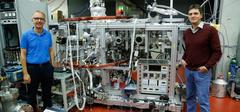URL: https://www.desy.de/news/news_search/index_eng.html
Breadcrumb Navigation
DESY News: Helmholtz Prize for science at FLASH
News
News from the DESY research centre
Helmholtz Prize for science at FLASH
For their high-precision measurements carried out at DESY’s free-electron laser FLASH, five research scientists from the Goethe University in Frankfurt am Main are to receive the Helmholtz Prize in Metrology. The team surrounding Reinhard Dörner, professor for atomic physics, used a special apparatus to study extremely weakly bound helium molecules. In the process, the scientists also discovered a molecule made of three helium atoms, which had been predicted 40 years ago but which scientists had hitherto failed to find. The Helmholtz Prize, which is endowed with 20,000 euros, is awarded for outstanding achievements in metrology, the science of measurement, and is presented to European researchers every three years by the independent Helmholtz Fund.

To achieve this, the researchers fired an intense beam of photons from FLASH at the helium and used their reaction microscope to determine the position and velocity of the disintegrating molecules. They were thereby able to calculate the original binding energy of these molecules with a high degree of accuracy. Their findings suggest that the bonds holding together He2 molecules are around one hundred million times weaker, at 152 neV, than for example the bonds in a water molecule (H2O). In the course of their series of experiments, the scientists also found evidence of the long elusive helium molecules consisting of three atoms (He3), which were predicted 40 years ago by the Russian theoretical physicist Vitaly Efimov.
“This excellent work is an outstanding example of high-precision metrology and demonstrates the enormous potential of DESY’s free-electron laser FLASH,” emphasises Edgar Weckert, who is in charge of photon-based research at DESY.
“All those who have won the Helmholtz Prize in the past have produced long-term advances in the art of measurement, and today many of them are among the most renowned researchers in the field of metrology,” says Joachim Ullrich, president of Germany’s national metrology institute, the Physikalisch-Technische Bundesanstalt (PTB), and chairman of the Helmholtz Foundation. “We feel certain that the same will be true this time.” The Helmholtz Prize is also being awarded to research scientists from the University of Cambridge for their measurements on individual molecules in DNA analysis using nanopores. The prize will be presented on 22 June 2016 at the PTB.
Homepage of Dörner’s work group: http://www.atom.uni-frankfurt.de/
Helmholtz Prize: http://www.helmholtz-fonds.de/helmholtz-preis/



